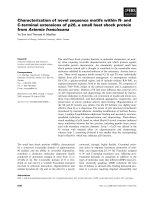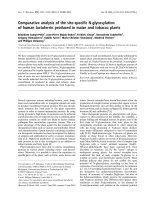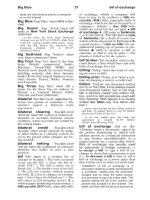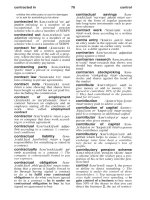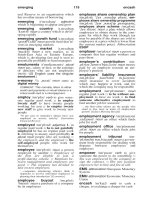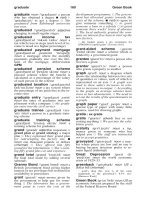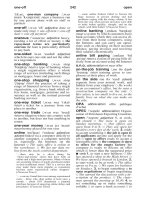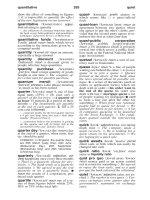Chemistry of cyclopentadienylchromium complexes containing c , n and s organic ligands
Bạn đang xem bản rút gọn của tài liệu. Xem và tải ngay bản đầy đủ của tài liệu tại đây (1.83 MB, 150 trang )
CHEMISTRY OF CYCLOPENTADIENYLCHROMIUM
COMPLEXES CONTAINING C-, N- AND S- ORGANIC
LIGANDS
NG WEE LIN, VICTOR
(B. Sc. (Hons.), NUS)
NATIONAL UNIVERSITY OF SINGAPORE
2004
CHEMISTRY OF CYCLOPENTADIENYLCHROMIUM
COMPLEXES CONTAINING C-, N- AND S- ORGANIC
LIGANDS
NG WEE LIN, VICTOR
(B. Sc. (Hons.), NUS)
A THESIS SUBMITTED FOR THE DEGREE OF MASTER
OF SCIENCE
DEPARTMENT OF CHEMISTRY
NATIONAL UNIVERSITY OF SINGAPORE
2004
Contents
Contents
Acknowledgements ...............................................................................................................
v
Abstract.................................................................................................................................. vi
Chart 1. Compounds encountered in this thesis.................................................................... viii
List of abbreviations ..............................................................................................................
x
List of figures .......................................................................................................................
xi
List of tables........................................................................................................................... xii
Chapter 1. Introduction
1.1
Chemistry of the tricarbonylcyclopentadienyl chromium dimer.......................... 1
1.2
2,5-Dimercapto-1,3,4-thiadiazolate complexes...……......................................... 14
1.3
Tetrazole complexes............…………................................................................. 21
1.4
2-Mercaptopyridine complexes............................................................................ 31
1.5
Cyclopentadienylchromium(III) complexes.….........…....................................... 39
1.6
Objectives………………………………………................................................. 43
Chapter 2. Results and discussion
2.1
The reaction of [CpCr(CO)3]2 with 2,5-dimercapto-1,3,4-thiadiazole
(DMcTH2)……………………………..…………………………...……....... 44
2.1.1 Products and reaction pathway................................................................ 44
2.1.2 Crystallographic studies.......................................................................... 47
2.1.3 Conclusion............................................................................................... 49
2.2
The reaction of [CpCr(CO)3]2 with 5,5’-dithiobis(1-phenyl-1H-tetrazole)
(STz)2……………………………………………..………………………..... 50
2.2.1 Products and reaction pathways.............................................................. 50
2.2.2 Mechanistic Considerations………........................................................ 52
2.2.3 Spectral features…………..………........................................................ 54
Chemistry of Cyclopentadienylchromium Complexes containing C-, N- and S- Organic Ligands
i
Contents
2.2.4 Crystallographic studies.......................................................................... 55
2.2.5 Conclusion............................................................................................... 59
2.3
Reactions of CpCr(CO)3(η1-STz) (4)...…….................................................... 60
2.3.1 Reactions with methylating agents……………….................................. 60
2.3.1.1 Products and reaction pathways………………………..…….. 61
2.3.1.2 Product Characterization………….……….………..………..
64
2.3.1.2 Conclusion…….. ………………………….…………..……..
69
2.3.2 Reaction with hydrochloric acid………….…………………………..
69
2.3.2.1 Products and reaction pathways………………………..…….. 69
2.3.2.2 Conclusion…….. ………………………….…………..……..
71
2.3.3 Reaction with iodine (oxidant)................................................................ 71
2.3.3.1 Products and reaction pathways………………………..…….. 72
2.3.3.2 Conclusion…….. ………………………….…………..……..
75
2.3.4 Reaction with iron pentacarbonyl........................................................... 75
2.4
The reaction of [CpFe(CO)2]2 with 5,5’-dithiobis(1-phenyl-1H-tetrazole)
(STz)2…………………………………..…………………………………..... 78
2.4.1 Products and reaction pathways.............................................................. 78
2.4.2 Crystallographic studies.…..................................................................... 78
2.4.3 Conclusion............................................................................................... 80
2.5
The reaction of [CpCr(CO)3]2 with 2,2’-dithiodipyridine (SPy)2................… 82
2.5.1 Products and reaction pathways.............................................................. 82
2.5.2 Crystallographic studies.......................................................................... 84
2.5.3 Conclusion.............................................................................................. 85
2.6
Reactions of CpCr(CO)2(η2-SPy) (16) …….....................……....................... 86
2.6.1 Reaction With HX (X = F, Cl, I)…………………................................. 86
2.6.1.1 Products and reaction pathways………………………..…….. 87
2.6.1.2 Product Characterization…………….…….………..………..
89
2.6.1.2 Conclusion……………..…………….…….………..………..
91
2.6.2 Reaction with iodine (oxidant)................................................................ 92
2.6.2.1 Products and reaction pathways………………………..…….. 92
Chemistry of Cyclopentadienylchromium Complexes containing C-, N- and S- Organic Ligands
ii
Contents
2.6.2.2 Conclusion ……………………………...…………..….…….. 93
2.6.3 With hexafluorophosphoric acid and triflic acid..........…….................. 93
2.6.3.1 Products and reaction pathways……………………..….…….. 99
2.6.3.1 Spectra characteristics ………………………………….…….. 94
2.6.3.3 Conclusion …………………….………………………..…….. 95
2.6.4 Reaction with dicyclopentadienylzirconium dichloride……………….. 95
2.6.4.1 Products and reaction pathways………………………..…….... 96
2.6.4.2 Properties and spectra characteristics …………….……..……. 97
2.6.4.3 Conclusion …………………….………………………..…….. 98
Chapter 3. Experimental
3.1
General procedures........................................................................................... 99
3.2
The reaction of [CpCr(CO)3]2 with 2,5-dimercapto-1,3,4-thiadiazole
(DMcTH2)………………………………………………………………....... 101
3.2.1 At ambient temperature………………………………...........................101
3.2.2 At 90 ºC.......................…………………………………………........... 102
3.2.3 NMR tube reactions................................................................................ 102
3.2.4 Crystal structure analyses………………………………………………103
3.3
The reaction of [CpCr(CO)3]2 with 5,5’-dithiobis(1-phenyl-1H-tetrazole)
(STz)2……………………………………………………………………….. 104
3.3.1 At –30 ºC.…………….......................……..……………..................... 104
3.3.2 At ambient temperature……..........................…………….....................104
3.3.3 Cothermolysis of CpCr(CO)3(SCN4Ph) with [CpCr(CO)3]2 at 90 ºC….105
3.3.4 Crystal structure analyses………………………………………………107
3.4
Reactions of CpCr(CO)3(η1-STz) (4).............................................................. 108
3.4.1 Reaction with trimethyloxonium tetrafluroborate…………...................108
3.4.2 Reaction with dimethylsulfate…………………………….....................108
3.4.3 Reaction with hydrochloric acid……………...…..…………………… 109
3.4.4 Reaction with iodine………................................................................... 110
3.4.5 Reaction with iron pentacarbonyl..…………………………..…..…… 111
Chemistry of Cyclopentadienylchromium Complexes containing C-, N- and S- Organic Ligands
iii
Contents
3.4.6 Crystal structure analyses........................................................................111
3.5
The reaction of [CpFe(CO)2]2 with 5,5’-dithiobis(1-phenyl-1H-tetrazole)
(STz)2……………………………………………………………………….. 113
3.5.1 At ambient temperature.......................................................................... 113
3.5.2 Crystal structure analyses. .................................................................... 114
3.6
The reaction of [CpCr(CO)3]2 with 2,2’-dithiodipyridine (SPy)2................… 115
3.6.1 At ambient temperature...........................................................................115
3.6.2 Crystal structure analyses........................................................................116
3.7
Reactions of CpCr(CO)2(η2-SPy) (16)…….....................……........................117
3.7.1 Reactions With HX (X = F, Cl, I)………............................................... 117
3.7.2 Reaction with iodine………................................................................... 119
3.7.3 Reactions with hexafluorophosphoric acid and triflic acid.....................119
3.7.4 Reaction with dicyclopentadienylzirconium dichloride............…..........121
3.7.5 Crystal structure analyses........................................................................122
Chapter 4. References....................................................................................................... 123
Chapter 5. Conclusion…………………...........................................................................132
5.1
Conclusion........................................................................................................132
Appendix
Appendix 1. Data collection and processing parameters.............................................. 134
Appendix 2. Selected listing of crystallographic data…...……………….. ...in CD-ROM
Chemistry of Cyclopentadienylchromium Complexes containing C-, N- and S- Organic Ligands
iv
Acknowledgements
ACKNOWLEDGEMENTS
I would like to thank my supervisor Dr. Goh Lai Yoong for her patience, guidance
and advice during the course of the project. In addition, special mention must be made to
Dr. Goh’s postgraduate, Mr. Weng Zhiqiang, for his invaluable knowledge and help
throughout the project.
I would also like to thank Associate Professors J. J. Vittal and W. K. Leong, Dr.
Koh, L. L. and Miss Tan G. K. for the various X-ray structured analyses. Thanks are also
due to members in the teaching and technical laboratories for their help with the facilities.
Last but not least, my sincere thanks to my family, members in my research group
including Richard Shin, Ng Sin Yee and Kuan Seah Ling, and friends, especially Mr.
Adrian Soo, Elaine Chan and Justin Loh for their kind support.
Chemistry of Cyclopentadienylchromium Complexes containing C-, N- and S- Organic Ligands
v
Abstract
Abstract
The reactivity of [CpCr(CO)3]2 (Cp = C5H5) (1) towards several classes of organoC-, N- and S- compounds have been studied. The organic substrates include: (i) 2,5dimercapto-1,3,4-thiadiazole, (DMcTH2), HS(CN2SC)SH; (ii) 5,5’-dithiobis(1-phenyl1H-tetrazole), (STz)2, (C6H5N4CS)2 and (iii) 2,2’-dithiodipyridine, (SPy)2, (C5H5NS)2.
The
primary
products
from
these
reactions
were
CpCr(CO)3(DMcTH)
(3),
CpCr(CO)3(STz) (4) and CpCr(CO)2(SPy) (16) respectively.
OC
OC
OC
H
OC
OC
OC
N
N
Cr
S
3
S
Cr
N
S
N
C
N
N
Cr
N
OC
S
S
OC
4
16
The cothermolysis of 4 with 1 at 90 °C led to the isolation of the aminocarbynecubane complex Cp4Cr4S3(N3Ph)(CpCr(CO)2CN) (5), the triazenido-cubane complex
Cp4Cr4S3(N3Ph) (6) and the coordination complex Cr(SCN4Ph)3 (7).
CpCr(CO)3(STz) (4) and CpCr(CO)2(SPy) (16) were reacted with acids, oxidizing
reagents and coordinating metal fragments.
The reaction of 4 with hydrochloric acid or iodine resulted in redox reactions,
which gave complexes CpCrCl2(CH3CN) (12) and CpCrI2(CH3CN) (13) respectively. The
organic thiolate fragments were either protonated (by HCl) or oxidized to the disulfide
(by I2). The reaction of 4 with methylating agents such as trimethyloxonium
tetrafluoroborate, Me3OBF4 and dimethylsulfate, (MeO)2SO2 give binuclear complex,
Chemistry of Cyclopentadienylchromium Complexes containing C-, N- and S- Organic Ligands
vi
Abstract
Cp2Cr2(µ-OH)(µ-η2-SCN4Ph)2BF4 (8) and trinuclear complex Cp3Cr3(µ2-OH)(µ3-O)(µ2η2-SCN4Ph)2(CH3OSO3) (9) respectively. These are the first examples of the 5mercapto(1-phenyl-1H-tetrazole) ligand bridging via the exocyclic thiolate sulfur and the
proximal endocyclic nitrogen.
The reaction of 16 with haloacids, namely HCl and HI also resulted in redox
reactions, which gave complexes CpCrCl2(SPyH) (17) and CpCrI2(SPyH) (18)
respectively. The organic thiolate fragments was protonated to 2-mercaptopyridine. The
reaction of 16 with iodine yielded CpCrI2(CH3CN) (13) together with the oxidized 2,2’dithiodipyridine. In addition, the reaction of 16 with dicyclopentadienylzirconium
dichloride, Cp2ZrCl2, also gave CpCrCl2(SPyH) (17) together with [Cp2ZrCl]2O (21).
The reactivity of [CpFe(CO)2]2 (Cp = C5H5) (2) towards (STz)2 was also
investigated. The reaction yielded the mercaptotetrazole complex CpFe(CO)2(η1-STz)
(15), a close analogue of 4.
Some of the isolated compounds were structurally characterized by X-ray
diffraction. The structures are illustrated in Chart 1.
Chemistry of Cyclopentadienylchromium Complexes containing C-, N- and S- Organic Ligands
vii
Compounds
Chart 1. Compounds encountered in this thesis. (Structurally characterized
complexes are marked with an asterix after its numbering, e.g. (X)*)
OC CO
OC
Cr
Cr
O
OC
H
Fe
CO
OC CO
Fe
CO
O
(1)
OC
OC
OC
N
N
Cr
S
S
Cr
OC
OC
OC
S
S
N
C
N
N
(4)*
(3)*
(2)
N
N
OC
Cr
Cr
C
OC
N
Cr
S
S
Cr
Cr
S
Cr
Cr
N
N
S
N
Cr
S
Cr
N
N
N
N
Cr
C
N
N
N
C
S
S
N
N
N
N
S
N
C
N
N
(5)*
(6)
N
H
O
BF4
N
N
(7)
Cr
C
N
Cr
H
O
S
N
Cr
C
N
C
S
N
Cl
(12)
N
N
S
(9)*
Cr
Cr
Solv
Cr
N
N
(8)*
Cl
N
C
N
N
S
Cr
O
N
N
MeOSO3
Cl
Cl
Cl
Cr
Cl
I
Solv
I
(12A)
Cr
Cr
(13)*
I
I
I
Cr
I
(13A)
Chemistry of Cyclopentadienylchromium Complexes containing C-, N- and S- Organic Ligands
viii
Compounds
Fe
N
OC
OC
Cr
N
N
S
Cl
S
OC
N
Cr
Cr
N
OC
S
I
Cl
H
(15)*
I
S
(16)*
H
N
(17)*
N
(18)
SH
N
Cr
F5PF
TfO
HS
Solv
2-mercapyopyridine
(20)
Cl
O
N
Solv
TfO
(19)
Zr
N
Cr
F5PF
OC
OC
OC
Cl
Cr
Cr
S
Cr
(25)
Cr
Cr
Cr S
Cr
CO
CO
CO
CO
(23)
S
Cr
Cr
O
O
OC
OC
H
(22)
(21)*
N
N
5-mercapto(1-phenyl-1H-tetrazole)
OC
OC
Zr
C
(24)
Cr
S
Cr
S
Cr
Cr
S
S
(26)
Chemistry of Cyclopentadienylchromium Complexes containing C-, N- and S- Organic Ligands
ix
Abbreviations
List of abbreviations
Cp
Cp*
br
Bu
calc.
CCD
d
ESI
Et
FAB-MS
h
i
Pr
KBr
m
m/z
M+
Me
min
mg
Ph
ppm
q
RT
s
sh
THF
UV-VIS
VT
w
ca.
et al.
i.e.
Hz
Å
δ
η5-cyclopentadienyl
η5-pentamethylcyclopentadienyl
broad
butyl
calculated
cold cathode-ray detector
doublet
Electrospray Ionisation
ethyl
Fast Atom Bombardment Mass Spectrometry
hour
isopropyl
potassium bromide
medium
mass to charge ratio
parent ion peak (mass spectrometry)
methyl
minute
milligram
phenyl
parts per million
quartet
room temperature
strong (IR) / singlet (NMR)
shoulder
tetrahydrofuran
Ultraviolet-Visible
variable temperature
weak
about (Latin circa)
and other (Latin et alii)
this is (Latin id est)
Hertz
angstrom
NMR chemical shift in ppm
Chemistry of Cyclopentadienylchromium Complexes containing C-, N- and S- Organic Ligands
x
List of figures
List of figures
Figure 1.3.1. The first tetrazole derivative, 2-phenyl-1,2,3,4-tetrazole-5 carbonitrile........... 21
Figure 2.1.1. Molecular structure of CpCr(CO)3(DMcTH) (3)……...................................... 48
Figure 2.2.1. Molecular structure of CpCr(CO)3(STz) (4)..................................................... 56
Figure 2.2.2. Molecular structure of Cp4Cr4S3(N3Ph)(CpCr(CO)2≡CN) (5)......................... 57
Figure 2.3.1. Molecular structure of Cp2Cr2(µ-OH)(µ-η2-STz)2BF4 (8)................................ 65
Figure 2.3.2. Molecular structure of Cp3Cr3(µ2-OH)(µ3-O)(µ2-η2-STz)2(CH3OSO3) (9)...... 67
Figure 2.3.3. Molecular structure of CpCrI2(CH3CN) (12) and CpCrCl2(CH3CN) (13)….. 75
Figure 2.4.1. Molecular structure of CpFe(CO)2(STz) (15)................................................... 79
Figure 2.5.1. Molecular structure of CpCr(CO)2(SPy) (16)................................................... 85
Figure 2.6.1. Molecular structure of CpCrCl2SPyH (17)…......………................................. 90
Figure 2.6.2 Molecular structure of [Cp2ZrCl]2O (21)...........……………............................ 97
Chemistry of Cyclopentadienylchromium Complexes containing C-, N- and S- Organic Ligands
xi
List of tables
List of tables
Table 1.2.1. Bonding modes of DMcTH complexes.....................……............................... 15
Table 1.3.1. Bonding modes of tetrazole and 5-mercaptotetrazole complexes....……......... 23
Table 1.4.1. Bonding modes of 2-mercaptopyridine complexes……………………..…….. 32
Table 2.1.1. Selected bond lengths (Å) and angles (deg) for 3.............................................. 48
Table 2.2.1. Selected bond lengths (Å) and angles (deg) for 4.............................................. 56
Table 2.2.2. Selected bond lengths (Å) and angles (deg) for 5.............................................. 58
Table 2.3.1. Selected bond lengths (Å) and angles (deg) for 8.....................................…..... 66
Table 2.3.2. Selected bond lengths (Å) and angles (deg) for 9.....................................…..... 68
Table 2.3.3. Comparison of selected bond lengths (Å) and angles (deg) for 12 and 1…….. 74
Table 2.4.1. Selected bond lengths (Å) and angles (deg) for 15............................................ 79
Table 2.5.1. Selected bond lengths (Å) and angles (deg) for 16............................................ 84
Table 2.6.1. Selected bond lengths (Å) and angles (deg) for 17............................................ 91
Table 2.6.2. Selected bond lengths (Å) and angles (deg) for 21............................................ 98
Chemistry of Cyclopentadienylchromium Complexes containing C-, N- and S- Organic Ligands
xii
Chapter 1: Introduction
Chapter 1
1.1
Chemistry of the tricarbonylcyclopentadienyl chromium
Introduction
Chemistry of the tricarbonylcyclopentadienyl chromium
While the majority of organometallic complexes satisfy the 18-electron rule, there
exists a few well-characterised 17-electron species and these have attracted intense
research interest on account of their high reactivity.1 These species are commonly
prepared by the scission of the metal-metal bonds via thermolysis or photolysis of their
corresponding 18-electron dimers,2 e.g. the tricarbonylcyclopentadienyl chromium dimer,
[CpCr(CO)3]2 (1) (Cp = C5H5) which is of particular interest in this research project.3 1
was synthesized in the late 1950’s and reactivity studies in the 1960’s by various research
groups point to radical processes.4 The X-ray crystal structure analysis by Adams,
Collins, and Cotton in 1974 showed the presence of an unusually long Cr−Cr bond
(3.281(1) Å),5 which is much longer than that of its heavier congener molybdenum and
tungsten analogues. This difference was attributed to steric repulsion between ligands in
the two halves of the molecule.
Scheme 1.1.1
OC CO
OC
Cr
Cr
2
OC CO
OC
Cr
CO
OC CO
1
1A
Cotton suggested that the dimer should readily dissociate into 17-electron
CpCr(CO)3⋅ (1A) radicals (Scheme 1.1.1) and this was later established by (i) UV-VIS
Chemistry of Cyclopentadienylchromium Complexes containing C-, N- and S- Organic Ligands
1
Chapter 1: Introduction
Chemistry of the tricarbonylcyclopentadienyl chromium
studies by McLain, which showed 10% dissociation to monomer radical 1A in roomtemperature in a 10 mM solution;6 (ii) ESR, UV-VIS and IR studies by Vahrenkamp;7
and (iii) ESR and NMR studies by Goh et al.8
OC CO
L
Chart 1.1.1
Cr
Cr
L
OC CO
Cr
OC
OC
Cr
Cr
OC
OC
L
L
OC
OC
2L
CO
X2
2L
X
CO
X = H, Cl, Br, I
OC CO
OC
Cr
Cr
RSSR
Cr
OC
OC
H2S
Cr
CO
OC CO
1
SR
CO
OC
OC
+
HS
H
CO
RX
Bu3SnH
RSH
+
Cr
OC
OC
SnBu3
CO
Cr
OC
OC
+
Cr
OC
OC
H
CO
Cr
OC
OC
Cr
OC
OC
R
CO
Cr
+
SR
CO
X
CO
OC
OC
H
CO
The wide range of reactions of 1 include, recombination, atom abstraction,
electron transfer, ligand association and rearrangement, which resembles intimately those
of organic radicals.9 Some of these reactions such as halogen abstraction, hydrogenation
and acyl migratory insertion are important elementary steps in catalytic cycles. The high
reactivity of 1 derives from the homolytic attack of 1A on hydrogen,10 halogens and
organic substracts eg, thiols,11 hydrogen sulfide,12 disulfides,13 organic halides,3a,3c and
Chemistry of Cyclopentadienylchromium Complexes containing C-, N- and S- Organic Ligands
2
Chapter 1: Introduction
Chemistry of the tricarbonylcyclopentadienyl chromium
trialkyltin hydrides.14 In addition, substitution15 and disproportionation16 reactions of 1
are also well documented. Some of these reactions are highlighted in Chart 1.1.1.
The reactions of [CpCr(CO)3]2 with the homo- and hetero-polyatomic molecules
of Groups 15 and 16 and diaryl dichalcogenides via a homolytic cleavage and aggregation
pathways have been reviewed by Goh et al. These are illustrated in Chart 1.1.2 for the
homonuclear chalcogenides and pnicogens, in Chart 1.1.3 for the heteronuclear
polyatomic group 15 and 16 molecules and in Chart 1.1.4 for organic dichalcogen.17,18
The facile reaction of 1 with elemental sulfur and selenium giving the
corresponding sulfido- and seleno- complexes is an indication of the capability of 1 as a
sulfur and selenide abstractor, and its preference for these soft atoms (“chalcophilic”).
The polycyclophosphidochromium cluster [CpCr(CO)2]5P10 (27), obtained from the
reaction of 1 with elemental yellow P4 was perhaps one of the most outstanding
products.19 The molecule consists of five CpCr(CO)2 fragments linked to the
polyphosphorus P10 core with each chromium joined to two P atoms (Scheme 1.1.2). Till
date, there has not been a report on an identical molecule consisting of the P10 moiety.
Chemistry of Cyclopentadienylchromium Complexes containing C-, N- and S- Organic Ligands
3
Chapter 1: Introduction
Chemistry of the tricarbonylcyclopentadienyl chromium
Chart 1.1.2
Cr
Cr
OC
OC
X
X
+
CO
CO OC
CO
Cr X
As
Cr
Cr
OC
CO
As
As
As
+
OC CO
OC CO
As
Cr
Cr
OC
CO
X = S, Se
Cr
As
As
As
As As
Cr
X
Cr
X
OC CO
Cp4Cr4S4
Cr
OC CO
S8 or Se2
As
OC CO
OC
Cr
Cr
CO
OC CO
1
P4
P
Cr
P
P
Cr
OC CO
CO
OC
Cr
P P OC
P
Cr
P
P
P
P
Cr
P
P
Cr
P
OC CO
Cr
P
P
P P
Cr
P
OC Cr CO
OC
P
OC
P
Cr
P
CO
Cr
P
P
OC
P
P
P
P
OC
Cr
P
CO
Cr
CO
OC
27
The reaction of [CpCr(CO)3]2 (1) with P4X3 (X = S, Se) at ambient temperature
led to the isolation of Cp4Cr4(CO)9(P4X3) (28),20 in which the molecular structure
revealed that the initial P4X3 cage had undergone multiple P−P and P−S bond cleavage
without fragmentation (Scheme 1.1.3). With X = Se, an additional product,
Chemistry of Cyclopentadienylchromium Complexes containing C-, N- and S- Organic Ligands
4
Chapter 1: Introduction
Chemistry of the tricarbonylcyclopentadienyl chromium
Cp4Cr4(CO)8(P2Se2) (29), was also isolated in which it contains a rare case of the P2Se2
moiety. The reaction of 1 with excess Sb2S3 gave the tetranuclear complex,
Cp4Cr4(CO)12(Sb2S) (30), which contains four CpCr(CO)3 units linked by a Sb2S unit
(Scheme 1.1.3).17d
Chart 1.1.3
OC CO
OC
Cr
Cr
Cr
OC
OC
Sb2S3
CO
OC CO
OC
Cr
S
Sb
Cr
1
CO OC
CO
CO
+
Sb
CO OC
CO OC
[CpCr(CO)2]2S
CO
24
Cr
30
X
P
X
X
P
P
X
X = S, Se
Cr
X
P
Cr
OC
P
OC
OC Cr
OC
CO
CO
P
X
P
CO
P
OC
OC
+
Cr
OC
Cr
P
Cr
Cr
CO
OC CO
Se
Se
CO
OC
OC
P
Cr
OC
29
28
+
CpCr(CO)3H
The reaction of 1 with PhXXPh (X = S, Se, Te) led to the isolation of
CpCr(CO)3(XPh) (31) which subsequently converts to [CpCr(CO)2(XPh)]2 (32) and
[CpCr(XPh)]2S (33) under thermolytic conditions (Chart 1.1.4).18
Chemistry of Cyclopentadienylchromium Complexes containing C-, N- and S- Organic Ligands
5
Chapter 1: Introduction
Chemistry of the tricarbonylcyclopentadienyl chromium
Chart 1.1.4
OC CO
OC
Cr
Cr
+
X
CO
OC CO
Cr
OC
X
X
CO
OC
X = S, Se, Te
31
1
OC
OC
X
X
Cr
Cr
Cr
X
X
X
33
32
Cr
CO
CO
These studies demonstrated that the tricarbonylcyclopentadienyl chromium radical
species has effectively and efficiently cleaved the S–S, P–P and S–P bond in polyatomic
molecules of Group 15 and 16 molecules, generating a series of remarkable complexes
having atypical bonding and structures.
Investigations of the reaction of [CpCr(CO)3]2 (1) with organic compounds,
containing S−S, P−P and S−P bonds (Chart 1.1.5), viz bis(thiophosphinyl)disulfanes,21
bis(thiophosphoryl)disulfanes,21 tetraalkyldiphosphine disulfides,22 Lawesson’s reagent,23
tetraalkylthiuram disulfides24 and dibenzothiazolyl disulfide,25 including the reactivity of
1 towards various Cr-E (E = C, N, P, S) bonds were carried out by Goh et al.26
Chemistry of Cyclopentadienylchromium Complexes containing C-, N- and S- Organic Ligands
6
Chapter 1: Introduction
Chemistry of the tricarbonylcyclopentadienyl chromium
Chart 1.1.5
R
R
R
P
S
S
S
P
S
RO
R
RO
Bis(thiophosphinyl)disulfanes
R'
R'
P
S
S
R
S
S
C
S
OR
S
P
P
S
Ar
S
Lawesson's Reagent
R
S
P
S
S
R'
S
Bis(thiophosphoryl)disulfanes
Ar
R
C
S
S
R'
P
Tetraalkyldiphosphine
disulfides
N
OR
P
S
N
S
S
R
Tetraalkylthiuram disulfides
N
S
N
Dibenzothiazolyl disulfides
The reaction of bis(thiophosphinyl)disulfanes and bis(thiophosphoryl)disulfanes
yielded very similar products, indicating that the auxiliary substituents on the phosphorus
do not significantly modify its reactivity towards 1 (Scheme 1.1.2). The formation of
CpCr(CO)2(S2PR2) (34) is not unexpected, however, the formation of the Cr(III) species,
Cr(S2PR2)3 (37), involving the loss of a Cp ligand was a rare phenomenon.21,26
Chemistry of Cyclopentadienylchromium Complexes containing C-, N- and S- Organic Ligands
7
Chapter 1: Introduction
Chemistry of the tricarbonylcyclopentadienyl chromium
Scheme 1.1.2
OC CO
OC
Cr
Cr
CO
OC CO
1
R'
+
R'
R'
P
S
S
S
P
S
Cr
R'
OC
OC
S
P
S
Bis(thiophosphinyl)disulfanes or
Bis(thiophosphoryl)disulfanes
R'
R'
34
∆
R'
R'
P
Cr
OC
OC
S
P
R'
P
R'
R'
S
Cr
S
+
S
S
S
P
R'
R' = Alkyl or OR
35
24
P
R'
36
[CpCr(CO)2]2S
+
Cr
S
R'
R'
S
+
R'
S
S
S
37
P
R'
R'
Cp4Cr4S4
26
The cleavage of P-P bonds in tetraalkyldiphosphine disulfides by 1 was reported
to require thermal activation. A series of di- and tri-nuclear complexes was obtained, all
having a bridging phosphido µ2-PR2 fragment. The tri-nuclear chromium complex (41)
contains a bridging sulfido µ3-S fragment, which adds to a family of such species of
which the butoxide- and nitrene-bridged analogues have been reported (Scheme
1.1.3).22,26
Chemistry of Cyclopentadienylchromium Complexes containing C-, N- and S- Organic Ligands
8
Chapter 1: Introduction
Chemistry of the tricarbonylcyclopentadienyl chromium
Scheme 1.1.3
OC CO
OC
Cr
Cr
CO
OC CO
1
R'
+
R'
Cr
R'
P
P
S
S
OC
OC
R'
S
P
R'
Tetraalkyldiphosphine
disulfide
R'
35
∆
OC
OC
R = Me, Et
Cr
+
Cr
P
R2
R2
P
OC
H
CO
CO
Cr
P
R2
39
Cr
+
Cr
OC
CO
S
CO
Cr
Cr
P
R2
40
∆
41
+
Cp4Cr4S4
26
The four-membered P2S2 ring with two P=S in the Lawesson’s reagent was
cleaved efficiently by 1. At ambient and elevated temperatures, two different series of
products were obtained (Scheme 1.1.4). In addition, the interaction of the primary product
obtained at elevated temperature, CpCr(CO)2(SPHAr) (45), with 1 was also investigated.
Surprisingly, it gave a completely new series of aggregated products (Scheme 1.1.5). A
detailed mechanism on the fragmentation and aggregation on the complex systems has
been proposed and interpreted by Goh et al.23,26
Chemistry of Cyclopentadienylchromium Complexes containing C-, N- and S- Organic Ligands
9
Chapter 1: Introduction
Chemistry of the tricarbonylcyclopentadienyl chromium
Scheme 1.1.4
S
Cr
OC
OC
OC
OC
OC
OC
CO
CO
Ar
S
Cr
+
Cr
P
P
Cr
S
Ar
CO
CO
43
42
RT
S
Cr
OC CO
OC
Cr
Cr
O
Ar
P
S
S
P
Ar
+
O
S
CpCr(CO)3H
+
[CpCr(CO)2]2S
24
22
Cr
44
CO
OC CO
1
+
S
Ar
S
P
P
Ar
S
S
Lawesson's Reagent
Cr
OC
OC
S
H
Ar = -C6H5OCH3
+
P
44
CpCr(CO)3H
+
+
[CpCr(CO)2]2S
24
22
Ar
45
∆
H3C
CO
Cr
OC
CO OC
P
P
S
S
CO
Cr
Cr
+
O
O
CH3
cis
46
H3C
O
CO
S
P
P
S
OC
O
Cr
OC
CH3
trans
47
Chemistry of Cyclopentadienylchromium Complexes containing C-, N- and S- Organic Ligands
10
Chapter 1: Introduction
Chemistry of the tricarbonylcyclopentadienyl chromium
Scheme 1.1.5
OC CO
OC
Cr
Cr
+
Cr
OC
OC
CO
OC CO
S
P
H
Ar
45
1
Ar = -C6H5OCH3
∆
Ar
OC
OC
OC
H
Cr
Cr
P
Ar
+
CO
H CO
H
P
Cr
Cr
Cr
P
H
+
S
Cr
Cr
S
S
CO
Cr
Ar
Cr
Ar
+
P
Cr
P
P
Ar
Ar
48
50
49
CpCr(CO)3H
22
+
S
Cr
Cr
S
51
Cp4Cr4S4
26
[The Cr-Cr bonds in the cuboidal cores of 50 and 51 are omitted for clarity]
The reaction of 1 with tetraalkylthiuram disulfides gave some extraordinary
results. At –29 °C, the rare monodentate product CpCr(CO)3(η1-S2CNR2) (52) could be
obtained at –29 °C in admixture with the bidentate product, CpCr(CO)2(η2-S2CNR2) (53),
the sole product at ambient temperature. The interaction of 1 with tetraalkylthiuram
disulfides at elevated temperatures yielded a series of structurally interesting complexes
(Scheme 1.1.6) including a thiocarbenoid complex, CpCr(CO)2(η2-SCNR2) (54), a
thiocarboxamido
dicubane-like
cluster,
Cp6Cr8S8(η2,η4-SCNR2)2
(55),
and
a
dithiocarbamate dicubane-like cluster, Cp6Cr8S8(η2,η4-S2CNR2)2 (56). The interaction of
1 with (53), (54), and the coordination complex, Cr(η2-S2CNR2)3 (57), was also
investigated and reviewed.24,26
Chemistry of Cyclopentadienylchromium Complexes containing C-, N- and S- Organic Ligands
11

